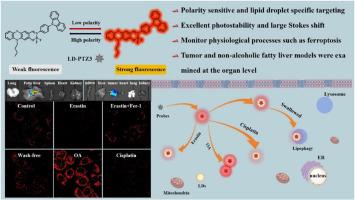一种针对脂滴的免洗极性荧光探针用于肿瘤和非酒精性脂肪肝的诊断
IF 4.2
3区 工程技术
Q2 CHEMISTRY, APPLIED
引用次数: 0
摘要
脂滴作为一种动态的、具有代谢活性的细胞器,在细胞稳态中起着至关重要的作用,其异常与多种代谢疾病的进展有关。值得注意的是,ld极性的改变与病理过程密切相关,如氧化应激、铁下垂,这突出了开发极性敏感的荧光探针来监测ld动态和阐明疾病机制的重要性。本文设计并合成了三种基于硼席夫碱(BOSCHIBA)小分子的荧光探针(LD-PTZ1-LD-PTZ3)。所构建的探针表现出优异的光物理特性,包括高光稳定性和大斯托克斯位移。其中,LD-PTZ1和LD-PTZ3对微环境极性变化高度敏感,特异性较好。此外,LD-PTZ1、LD-PTZ2和LD-PTZ3均具有良好的ld定位能力。有趣的是,LD-PTZ3不仅可以通过无洗过程跟踪ld的动态变化,还可以可视化不同生理状态下ld极性的变化,并评估抗癌药物的疗效。此外,LD-PTZ3还可用于肿瘤和非酒精性脂肪肝的器官水平诊断。LD-PTZ3探针以其优异的性能为设计和合成更多针对ld的荧光探针奠定了理论基础,有望进一步推动ld研究领域的发展。本文章由计算机程序翻译,如有差异,请以英文原文为准。

A wash-free polarity fluorescent probes targeting lipid droplets for the diagnosis of tumor and non-alcoholic fatty liver disease
Lipid droplets (LDs), as dynamic and metabolically active organelles, play crucial roles in cellular homeostasis, and their abnormalities are implicated in the progression of several metabolic disorders. Notably, alterations in LDs polarity are closely associated with pathological processes, such as oxidative stress, ferroptosis, highlighting the importance of developing polarity-sensitive fluorescent probes for monitoring LDs dynamics and elucidating disease mechanisms. Herein, three fluorescent probes (LD-PTZ1-LD-PTZ3) based on Boron Schiff Base (BOSCHIBA) small molecules were designed and synthesized in this paper. The constructed probes demonstrated exceptional photophysical properties, including high photostability and large Stokes shifts. Especially, LD-PTZ1 and LD-PTZ3 were highly sensitive to microenvironmental changes in polarity with excellent specificity. In addition, LD-PTZ1, LD-PTZ2 and LD-PTZ3 all possessed good LDs targeting ability. Interestingly, LD-PTZ3 can not only track the dynamic changes of LDs through wash-free procedure, but also visualize the changes in LDs polarity under different physiological states and evaluate the efficacy of anticancer drugs. Moreover, LD-PTZ3 was also used for the diagnosis of tumors and non-alcoholic fatty liver at the organ level. With its excellent properties, probe LD-PTZ3 lays a theoretical foundation for the design and synthesis of more fluorescent probes specifically targeting LDs, which was expected to further advance the field of LDs research.
求助全文
通过发布文献求助,成功后即可免费获取论文全文。
去求助
来源期刊

Dyes and Pigments
工程技术-材料科学:纺织
CiteScore
8.20
自引率
13.30%
发文量
933
审稿时长
33 days
期刊介绍:
Dyes and Pigments covers the scientific and technical aspects of the chemistry and physics of dyes, pigments and their intermediates. Emphasis is placed on the properties of the colouring matters themselves rather than on their applications or the system in which they may be applied.
Thus the journal accepts research and review papers on the synthesis of dyes, pigments and intermediates, their physical or chemical properties, e.g. spectroscopic, surface, solution or solid state characteristics, the physical aspects of their preparation, e.g. precipitation, nucleation and growth, crystal formation, liquid crystalline characteristics, their photochemical, ecological or biological properties and the relationship between colour and chemical constitution. However, papers are considered which deal with the more fundamental aspects of colourant application and of the interactions of colourants with substrates or media.
The journal will interest a wide variety of workers in a range of disciplines whose work involves dyes, pigments and their intermediates, and provides a platform for investigators with common interests but diverse fields of activity such as cosmetics, reprographics, dye and pigment synthesis, medical research, polymers, etc.
 求助内容:
求助内容: 应助结果提醒方式:
应助结果提醒方式:


